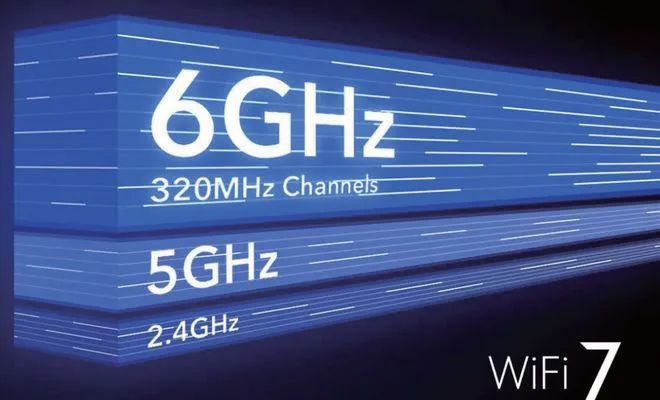This surge is driven not only by the growth of devices but also by a class of new ultra-demand applications, such as multi-user augmented reality/virtual reality (AR/VR), immersive gaming, and industrial Internet of Things (IIoT). They pose entirely new performance requirements that far exceed the capabilities of existing Wi-Fi technology. As these applications become more prevalent, we need new Wi-Fi technology to support them. The answer is Wi-Fi 7.
Compared to Wi-Fi 6E, Wi-Fi 7 has the following advantages:
-
Faster transmission speeds
-
Significantly increased number of simultaneous connections
-
Ultra-low latency
-
Stronger performance under high interference
-
Cost-effective
Wi-Fi 7 will officially launch in January 2024, and certified Wi-Fi 7 products are already on the market. In fact, the Wi-Fi Alliance expects to deploy over 233 million Wi-Fi 7 devices in 2024.
In-Depth Analysis of Wi-Fi 7
Wireless radio frequency (RF) spectrum is the most valuable resource for wireless networks. For wireless devices to communicate independently on a wireless network, each device needs to send or receive data on a narrow segment of RF spectrum called a resource unit (RU). The more spectrum available for network coverage, the more RUs there are, and the more devices the network can support.
Initial generations of Wi-Fi technology operated in bands around 2.4GHz and 5.5GHz. You can think of it as parallel highways, with each highway carrying a single passenger car. To increase the capacity for connected devices, Wi-Fi 6E and Wi-Fi 7 added another band around 6.5GHz. This is equivalent to adding another parallel highway, instantly increasing the number of devices the network can support. The capacity of this new “highway” far exceeds the total capacity of the previous two highways.
The main frequency bands are divided into channels (or lanes in our highway analogy), and each channel is further divided into RUs. In traditional Wi-Fi technology, devices monopolize an entire channel during their session, preventing other devices from using it. If you’ve ever found yourself unable to connect to a network in a crowded venue or exhibition, it’s likely because there weren’t enough links to support all the devices in that area. This leads us to the first key upgrade of Wi-Fi 7.
Wi-Fi 7 Expands to 320MHz Channels
While extending Wi-Fi 6E to the 6GHz RF band increased capacity, that standard limited channel width to 160MHz. Wi-Fi 7 expands channel width to 320MHz, effectively doubling the number of channels in the 6GHz band. Returning to our road analogy, we are actually doubling the number of lanes, transforming it into a super highway with massive capacity. Wi-Fi 7 also includes other subtle enhancements that further maximize the network’s effective use of spectrum.

(Image from the internet)
Multi-Link Operation (MLO)
Flexible use of spectrum is another significant advancement of Wi-Fi 7. Previous generations of Wi-Fi technology restricted devices to using only one channel during each session. If the channel couldn’t provide the required performance, there were no other solutions.
Wi-Fi 7’s MLO technology allows networks to connect devices simultaneously through different channels or even different bands during the same session. This technology maximizes network performance and usage efficiency. It’s similar to vehicles being able to change lanes, switch highways, or even use auxiliary roads to avoid traffic congestion.
MLO also provides other important advantages. In previous versions of Wi-Fi, devices could either transmit or receive but not perform both operations simultaneously. MLO enables Wi-Fi devices to do both at the same time.
MLO can ultimately significantly increase throughput. Additionally, MLO equips Wi-Fi 7 with two features supporting mesh networks. These dynamic and self-healing networks are very useful for applications such as automated warehousing, smart factories, and medical centers.
Higher Order Modulation Schemes
Modulation is a technique for encoding data onto wireless signals. Wi-Fi 7 uses 4096 Quadrature Amplitude Modulation (QAM), which allows Wi-Fi 7 devices to accommodate more data on the same channel. You can think of it as the difference between a single passenger car on a data lane and a fully loaded vehicle carrying 12 people. Compared to Wi-Fi 6E, which uses 1024 QAM, the 4096 QAM increases data throughput by 20%.
Lower Latency—Far Below Wi-Fi 6E
Latency refers to the delay caused by the network during the transmission of data from the sending device to the receiving device. Due to advancements such as MLO and 4096 QAM, Wi-Fi 7 provides lower latency than its predecessor. This is particularly beneficial for applications like augmented reality (AR) and virtual reality (VR), as well as immersive gaming, which aim to mimic human reaction times.
Multimedia Priority Service (MPS)
Wi-Fi 7 introduces several new features, the most important of which is Multimedia Priority Service (MPS). It allows Wi-Fi networks to define priority users and allocate resources to them preferentially.
One example is during natural disasters or other catastrophic events, where communications between emergency personnel and emergency management personnel are prioritized. Normally, emergency personnel have the same priority as all other users when accessing the network. In emergencies, the network can become congested. MPS provides a way to ensure that priority users like emergency personnel can gain access.
Advantages and Applications of Wi-Fi 7
Some applications that can benefit from Wi-Fi 7 are gradually becoming mainstream, from ultra-high-definition video streaming to providing Wi-Fi networks for numerous devices in smart homes—including remote work/e-learning video conferencing. Some upgrades of Wi-Fi 7 focus on broader applications of these technologies, but most are aimed at performance-intensive applications that are about to become mainstream. Here are a few:
Industrial Internet of Things (IIoT)
The Internet of Things (IoT) has gained attention in areas like homes, offices, and retail, but market forecasts show that the Industrial Internet of Things (IIoT) will far exceed the scale of these areas. From factories to utilities to logistics and transportation, modern industrial environments increasingly rely on networked devices. Sensors and smart components transmit data for predictive maintenance and analysis, while network device controllers support remote troubleshooting and operations.
Using Wi-Fi requires far less capital expenditure than wired systems while increasing flexibility (such as reconfigurable factories). In addition to high capacity and coverage, these applications also need to achieve 99.999% reliability, rock-solid security, and deterministic communication to ensure that all data and commands reach their destinations without delay or interference.
With its significantly enhanced throughput, extensive coverage, and extremely low latency, Wi-Fi 7 is the ideal choice to meet these demands.
Multi-User AR/VR
Augmented reality (AR), virtual reality (VR), or some combination (extended reality, or XR) are performance-intensive applications. Synchronizing data transmission from a single access point to multiple users requires ultra-high throughput and connectivity while maintaining the lowest latency and minimizing interference. The special features of Wi-Fi 7, including MLO and 4096 QAM, make this technology very suitable for these emerging applications.
Immersive Gaming and Entertainment
AR and VR elevate gaming and entertainment to a new level by providing rich, immersive experiences—but only when running on networks specifically configured for them. Current challenges include everything from cloud gaming to multiplayer online games to large-scale multiplayer events. The network needs to provide the same massive throughput to showcase the vivid details of the games, as well as extensive coverage to connect not just players but also audience and broadcasting devices.
More importantly, these applications require the lowest latency to translate player actions into in-game actions in real time. Wi-Fi 7’s higher throughput, 320MHz channel width, and 1 millisecond latency can keep up with the pace of gaming.
Wireless Communication in Medical Centers
Today, large medical centers are super users of wireless communication. This began with medical telemetry technology, which requires the transmission of a range of critical data. Staff use laptops and tablets to view patient records and test results or to view images. Don’t forget about patients and their families, who also have their smartphones, tablets, and laptops at hand.
Peak usage is unpredictable, and the network is constantly being reconfigured. Reliability is crucial—lives literally depend on network connections—while security is a close second.
These demands are exactly where Wi-Fi 7 excels. It is designed to efficiently utilize spectrum, while Multimedia Priority Service (MPS) technology makes it possible to prioritize access and data transmission for healthcare personnel on the network, ensuring that patients receive the best care.
Challenges Facing Wi-Fi 7 Development
There has been much discussion about the performance enhancements of Wi-Fi 7, but these enhancements do not come without design challenges, from board-level to higher levels. Some of these challenges include thermal management to minimize the heat generated by electronic devices.
4096 QAM significantly improves throughput, but its implementation is much more challenging than 1024 QAM and requires specialized high-performance power amplifiers. Using 320 MHz channels makes this challenge even more daunting, and all of the above factors generate more heat. Additionally, specialized bulk acoustic wave (BAW) filters are needed to reduce interference between bands used in MLO. As always, the industry has risen to the challenge, but product quality remains paramount.
Wi-Fi 7 Can Meet the Demands of Emerging Applications
When the iPhone was released in 2007, no one anticipated the emergence of a multi-billion-dollar app economy. Wi-Fi 7 aims to meet the demands of various emerging applications, but its features—higher throughput, significantly expanded capacity, spectrum efficiency, security, reliability, and ultra-low latency—will pave the way for more applications.
Achieving this technological advancement requires an ecosystem. As Wi-Fi 7 enters the mainstream market, and with Wi-Fi 8 (yes, already in development) entering the product development phase, Wi-Fi technology will empower more applications.
Source: TechSugar
Reviewed by: Zhao Lixin
